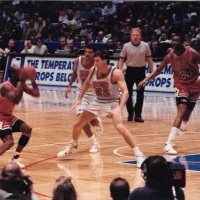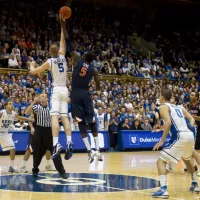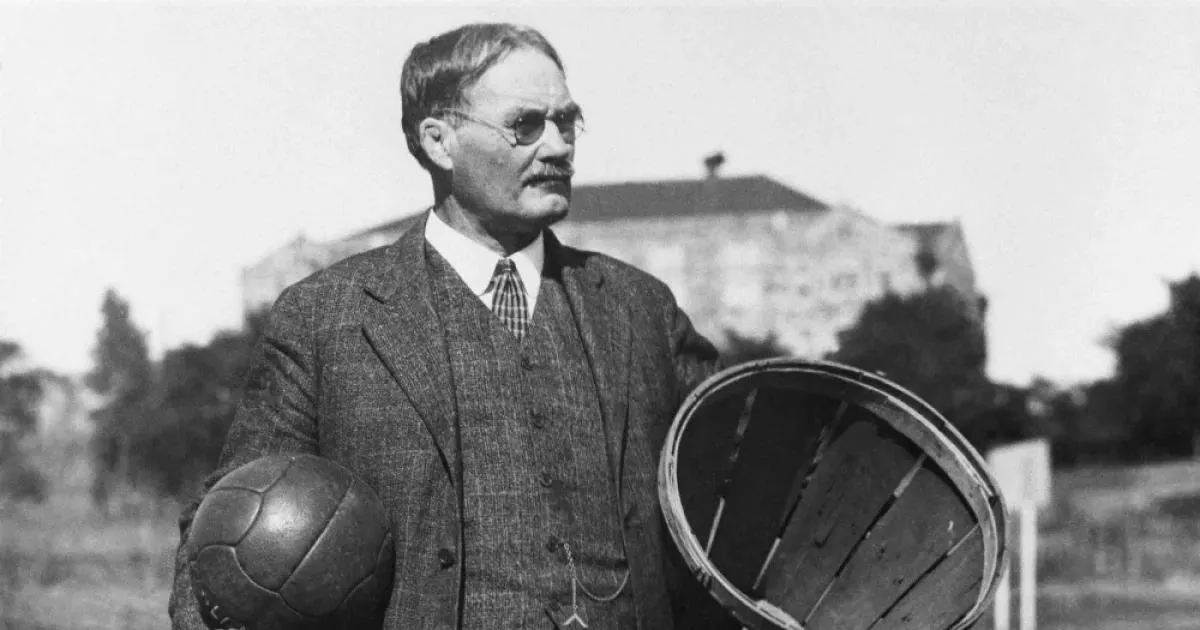James Naismith was a Canadian-American physical educator, physician, and sports coach who invented basketball. He developed the game's original rules and established the basketball program at the University of Kansas. Naismith witnessed basketball's rise in popularity, including its inclusion as an Olympic demonstration sport and later an official event. He also saw the establishment of significant basketball tournaments like the NIT and NCAA Tournament.
1904: Basketball as an Olympic Demonstration Sport
In 1904, basketball was introduced as a demonstration sport at the Summer Olympics in St. Louis. James Naismith, the inventor of the game, lived to see this significant milestone in the sport's history.
1904: Naismith Discourages Allen from Coaching
In 1904, despite inventing basketball, James Naismith discouraged Forrest "Phog" Allen from pursuing a coaching career in the sport. Allen, however, went on to become a renowned basketball coach and joined Naismith in the Basketball Hall of Fame.
1909: Naismith's Duties Redefined
In 1909, James Naismith's duties at the University of Kansas were redefined as a professorship. He also served as the de facto athletic director during much of the early 20th century.
1910: Honorary PE Master's Degree
In 1910, James Naismith received an honorary PE master's degree, recognizing his significant contributions to the field of physical education.
1911: Publication of 'A Modern College'
In 1911, James Naismith published the book 'A Modern College,' contributing his thoughts and expertise to the field of education.
1916: Patrols the Mexican Border
In 1916, James Naismith patrolled the Mexican border for four months, demonstrating his commitment to public service beyond his contributions to sports and physical education.
1918: Publication of 'Essence of a Healthy Life'
In 1918, James Naismith published 'Essence of a Healthy Life,' sharing his insights on health and physical well-being.
1922: Adolph Rupp's Championship Team
In 1922, Adolph Rupp, another player coached by Forrest "Phog" Allen, was part of the University of Kansas team that won the Helms Foundation National Championship. Rupp would go on to become a legendary basketball coach.
February 18, 1923: Naismith Joins Sigma Phi Epsilon
On February 18, 1923, James Naismith was initiated as a member of the Sigma Phi Epsilon fraternity by its national office. This was part of his effort to bring a chapter of the fraternity to the University of Kansas.
April 28, 1923: Founding of KU's Sigma Phi Epsilon Chapter
On April 28, 1923, the Sigma Phi Epsilon chapter at the University of Kansas was officially chartered under the leadership of James Naismith. He served as Chapter Counselor for the next 16 years.
May 4, 1925: Naismith Becomes an American Citizen
On May 4, 1925, James Naismith became an American citizen. This marked an important personal milestone for the Canadian-born inventor of basketball.
1935: Naismith Witnesses Basketball in Olympics
In 1935, the National Association of Basketball Coaches collected money to send James Naismith to witness basketball's introduction as an official Olympic sport at the 1936 Summer Olympics in Berlin. Naismith handed out medals to the winning teams and was named honorary president of the International Basketball Federation during the event.
1936: Basketball at the 1936 Summer Olympics
Basketball became an official event at the 1936 Summer Olympics in Berlin. James Naismith witnessed this milestone, marking a significant expansion of the sport he invented.
1936: Basketball's Olympic Debut
In 1936, basketball debuted as an official Olympic sport at the Summer Olympics in Berlin. James Naismith, the inventor of the game, witnessed this historic moment and handed out medals to the top teams.
1936: Men's Basketball Debuts at the Olympics
The year 1936 marked a significant milestone in basketball history as the sport made its debut at the Olympic Games in Berlin, Germany, featuring men's teams.
1937: Naismith's First Wife Passes Away
In 1937, James Naismith experienced the loss of his first wife.
1937: Formation of NAIB
In 1937, James Naismith played a role in the formation of the National Association of Intercollegiate Basketball, which later became the National Association of Intercollegiate Athletics (NAIA). This organization helped further the development of college basketball.
1937: Naismith Retires from Kansas
In 1937, James Naismith retired from his position at the University of Kansas, becoming professor emeritus. He had served the university for nearly 40 years in various roles, including coach and athletic director.
1938: Honorary Doctorates for Naismith
In 1938, James Naismith received honorary doctorates from both McGill University and Presbyterian College in Montreal, recognizing his contributions to physical education and sports.
1938: Birth of the National Invitation Tournament
In 1938, the National Invitation Tournament (NIT) was established, further solidifying basketball's growing popularity. James Naismith, the inventor of basketball, saw this development near the end of his life.
January 1939: Naismith's Radio Interview
In January 1939, James Naismith gave a radio interview where he detailed the first game of basketball and the initial rules that were used. This interview provided valuable insights into the origins of the sport.
June 11, 1939: Naismith's Second Marriage
On June 11, 1939, James Naismith married his second wife, following the passing of his first wife in 1937.
November 28, 1939: James Naismith's Death
James Naismith passed away on November 28, 1939. He was the Canadian-American physical educator, physician, Christian chaplain, and sports coach best known for inventing the game of basketball. His legacy includes the original basketball rule book and the founding of the University of Kansas basketball program.
1939: Honorary Doctorates and End of Career
In 1939, James Naismith received honorary doctorates from both McGill University and Presbyterian College in Montreal, marking the end of his esteemed career in physical education.
1939: Naismith's Death and Legacy
In 1939, James Naismith suffered a fatal brain hemorrhage and was interred at Memorial Park Cemetery in Lawrence, Kansas. His legacy includes the publication of his masterwork 'Basketball — its Origins and Development' posthumously in 1941, and having several landmarks named in his honor in Lawrence.
1939: Naismith's Role in Sigma Phi Epsilon
In 1939, James Naismith was still actively involved with the Sigma Phi Epsilon fraternity at the University of Kansas, serving as Chapter Counselor until his death. He deeply influenced the fraternity members and married the housemother, Mrs. Florence Kincaid.
1941: Publication of Naismith's Masterwork
In 1941, James Naismith's masterwork 'Basketball — its Origins and Development' was published posthumously, detailing the history and development of the game he invented.
1952: Dean Smith's Championship Team
In 1952, Dean Smith, a player coached by Forrest "Phog" Allen, was part of the University of Kansas team that won the National Championship. Smith would later become a legendary basketball coach himself.
1959: Inaugural Inductee into the Naismith Memorial Basketball Hall of Fame
In 1959, James Naismith was among the first individuals to be inducted into the Naismith Memorial Basketball Hall of Fame, a testament to his significant contributions to the sport.
1976: Naismith Designated a National Historic Person
In 1976, James Naismith was officially recognized for his significant contributions to Canadian history and heritage when he was designated a National Historic Person.
1976: Women's Basketball Included in the Olympics
In 1976, women's basketball was officially included in the Summer Olympics held in Montreal, Canada, expanding the sport's global reach and impact.
1977: Florence Kincaid Passes Away
Florence Kincaid, who would later become James Naismith's second wife, passed away in 1977 at the age of 98.
1991: Stamps Commemorate Basketball Centennial
The year 1991 marked the 100th anniversary of basketball's invention, an occasion commemorated by the issuance of postage stamps in both Canada and the United States.
2009: Canadian Stamp Honors Basketball Invention
In 2009, Canada issued another postage stamp to honor the invention of basketball, further solidifying James Naismith's legacy in the country.
December 2010: Original Basketball Rules Auctioned
In December 2010, the original rules of basketball, handwritten by James Naismith in 1891, were put up for auction at Sotheby's in New York.
2012: ESPN Documentary "There's No Place Like Home"
The story behind the acquisition of the original basketball rules was featured in a 2012 ESPN 30 for 30 documentary titled "There's No Place Like Home."
June 21, 2013: Induction into the Kansas Hall of Fame
On June 21, 2013, James Naismith was posthumously inducted into the Kansas Hall of Fame during a ceremony in Topeka.
March 2016: Debruce Center Opens at the University of Kansas
The University of Kansas opened the Debruce Center in March 2016, an $18 million facility specifically built to house and display the original rules of basketball.
July 2019: Naismith Inducted into Toronto's Walk of Fame
In July 2019, James Naismith was posthumously inducted into Toronto's Walk of Fame, recognizing his significant contributions to Canadian sports and culture.
January 15, 2021: Google Doodle Celebrates James Naismith
On January 15, 2021, Google honored James Naismith with a Google Doodle displayed on its homepage across 18 countries and five continents.
Mentioned in this timeline

Basketball is a team sport played on a rectangular court...

Google LLC is a multinational technology company specializing in online...

College basketball in the U S is governed by bodies...
Germany officially the Federal Republic of Germany is a Western...
Canada is a North American country the second largest in...
The modern Olympic Games are a leading international sporting event...
Trending

Simon Cowell is a prominent English television personality and businessman recognized for his role as a judge on various talent...

7 months ago Gary Payton Reflects on Jordan Matchup and Hypothetical Stats in Today's NBA

11 days ago Spurs Defeat Nuggets in Thrilling Game, Mavericks Face Nuggets

22 days ago Michael Douglas and Catherine Zeta-Jones Celebrate 25 Years of Marriage with Throwbacks
Luke Kornet is an American professional basketball player currently playing for the San Antonio Spurs in the NBA He's a...

6 months ago Jack Black's Minecraft Movie Sets Premiere on HBO Max, June 20, 2025
Popular

Candace Owens is an American conservative political commentator and author...

Ilhan Omar is an American politician currently serving as the...

XXXTentacion born Jahseh Dwayne Ricardo Onfroy was a controversial yet...

Tom Cotton is an American politician and Army veteran currently...
The Kennedy Center Honors are annual awards recognizing individuals and...

Kelsey Grammer is an accomplished American actor producer and singer...
